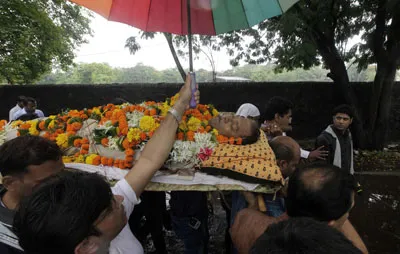New Delhi-based Tehelka weekly news magazine has published a scathing indictment of the police investigation into the 2011 killing of Mumbai crime reporter Jyotirmoy Dey–and of the Indian media’s coverage of it. Beneath the allegations and the rumors, we still don’t know exactly why he was killed, while the self-confessed mastermind is a fugitive from justice. Meanwhile, a second journalist has been indicted for the crime on apparently flimsy evidence.
The plot thickens
On the face of it, Dey’s death in June 2011 was a classic case of a veteran reporter executed for digging too deeply into the subject he had covered exhaustively for 22 years: Mumbai’s criminal underbelly. But the investigation took an unexpected turn in November when police arrested Jigna Vora, the 37-year-old deputy bureau chief of Indian daily The Asian Age, claiming they had “strong evidence” implicating her in the murder, local news reports said. She denied wrongdoing, but more than three months later, she was indicted under organized crime laws for conspiring with mafia boss Chhota Rajan to kill Dey over a professional rivalry — a charge which carries a possible death penalty, according to the reports. Local journalists reported that Dey may have been involved with a rival gang, even travelling to London to share information about Rajan’s activities with an exiled don. Suddenly, the case didn’t seem quite so straightforward.
CPJ spoke with several Indian press freedom advocates as the investigation developed, but no one knew what to make of it. Had Dey been sucked into the mob rivalry he claimed to cover objectively, as the media was widely reporting? Had Jigna Vora really exchanged 36 phone calls with the fugitive gangster Rajan in the days before Dey’s murder, as police told local media?
The mafia calling the shots
Apparently not: Chhota Rajan himself planted both stories, according to Tehelka. The fugitive, who is wanted on multiple criminal counts, admitted to masterminding the hit on Dey in calls made in person to a series of Hindi-language TV stations. These PR exercises launched rumors about the journalist’s underworld connections overseas, which were supplemented by police interviews about Dey’s “mysterious tour” abroad — which Tehelka says was a simple vacation. Yet police and reporters accepted Rajan’s analysis with very few exceptions.
Rajan also told TV channels that Jigna Vora “instigated” the killing, according to Tehelka. Again, his account was barely contested. One Hindi-language TV station refused to run Rajan’s comments on grounds they were malicious, Tehelka reports. Police commissioner Himanshu Roy, on the other hand, repeated the story almost verbatim to The Times of India as recently as last month: “There are transcripts of Rajan saying that he regretted killing Dey and it happened because Jigna instigated him.”
The February 21 charge sheet against Vora ran to 1,400 pages, but did not list the 36 calls between Vora and Rajan that journalists had unquestioningly reported. Only three calls were confirmed, all in reference to an interview Rajan gave The Asian Age, according to Tehelka. The professional rivalry at the heart of the motive, meanwhile, appeared to be based solely on conflicting stories the journalists had each penned on the same topic in one week in May 2011. And the transcripts of Rajan implicating Vora? Tehelka published the relevant extract: “You know that Jigna Vora…Jigna Vora used to say all the time that he (Dey) was in touch with them (the rival Dawood gang).” Meanwhile Vora remains in custody with deteriorating health, according to The Indian Express.
Let’s be clear about the implications of this report: In Tehelka’s analysis, the source for Dey’s and Vora’s alleged underworld involvement is Dey’s murderer. His account was apparently unchallenged by the majority of their colleagues and the police. Rajan, who is wanted by police for two decades, admitted to the crime on television, yet his victim and a suspect he implicated became the focus of the investigation.
The real truth?
Police officials and journalists have generated thousands of pages between them, but they have all failed J Dey. Besides Jigna Vora, another 10 suspects are on trial, but the man behind it all remains at large. And police have yet to discover whether it was Dey’s reporting that put him at risk.
Tehelka believes police ignored two early leads: Dey was investigating Rajan’s personal life, and had caused the reassignment of a Mumbai police officer after alleging he had links to organized crime.
Ruhi Khan, a U.K.-based journalist who has written about the case for CPJ, believes the Tehelka investigation paints a credible case that Dey was targeted for his work — or, at the very least, that the police have not done due diligence in investigating this angle. “The role of journalist Jigna Vora in Dey’s murder was always suspect,” she told CPJ by email. “This report definitely raises some serious doubts on the police theory.”
Geeta Seshu, who condemned the Indian media’s coverage of Jigna Vora back in December on the media watchdog website The Hoot, agreed. “As to whether Dey was targeted for his work, the police are simply not pursuing this course of investigation,” she told CPJ. “I’m still unclear why Dey was killed.”
CPJ has occasionally funded Tehelka reporting on press freedom issues with the John S. and James L. Knight Foundation.
